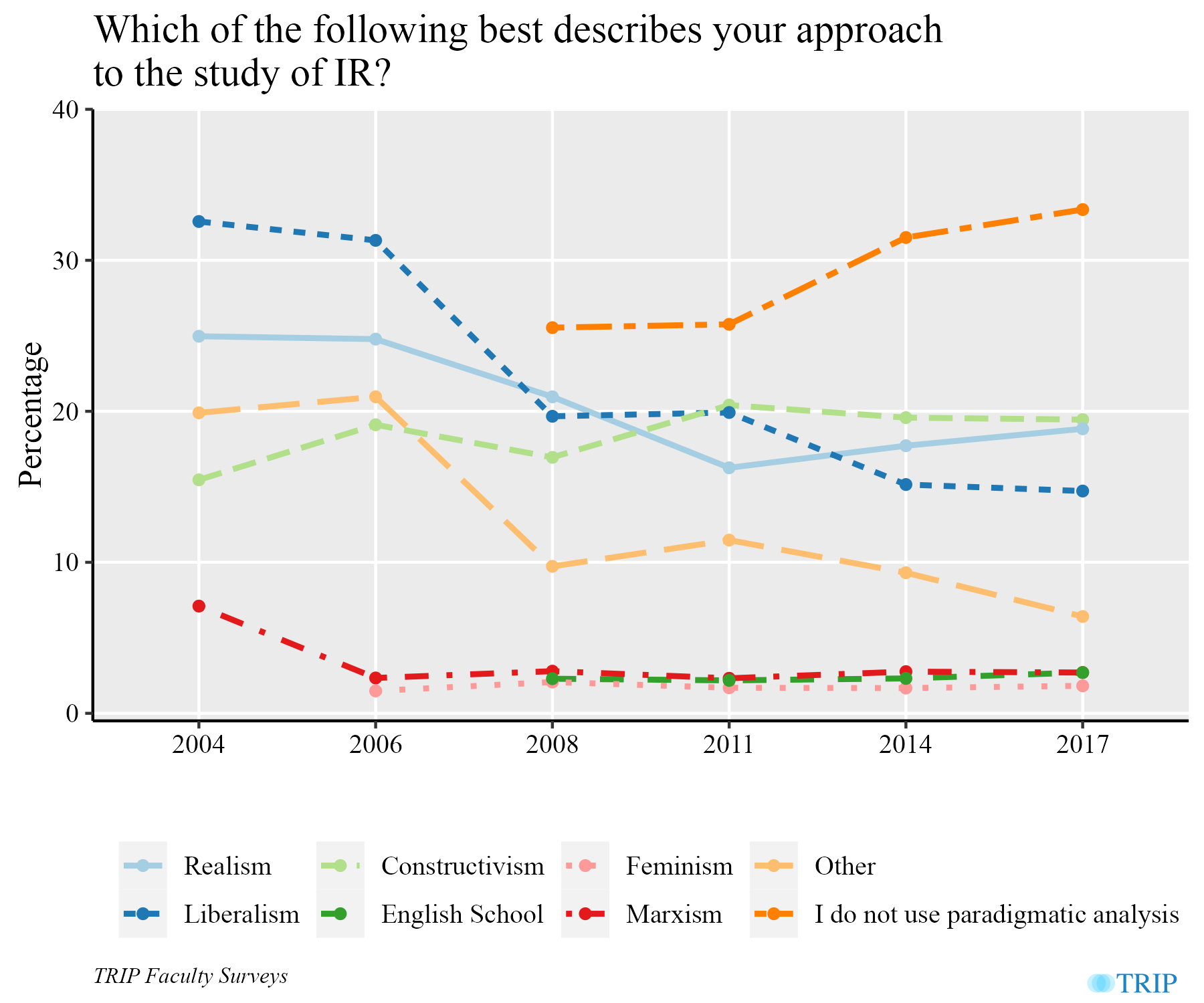The 2017 TRIP Faculty Survey surveyed scholars of international relations in 36 countries and 14 languages to examine teaching and research trends and foreign policy views in the IR discipline. TRIP surveys all international relations scholars employed at a college or university who have an affiliation with a political science department or school of public policy and who teach or conduct research on issues that cross international borders. A full summary of the methodology can be found in "International Relations in the U.S. Academy" (ISQ, 2011).
For survey results, see the following reports:
Topline Report U.S. Faculty and
Topline Report International Faculty
A list of our country partners can be found here.
How to cite 2017 Faculty Survey data
Maliniak, Daniel, Susan Peterson, Ryan Powers, and Michael J. Tierney. 2017. TRIP 2017 Faculty Survey. Teaching, Research, and International Policy Project, Williamsburg, VA: Global Research Institute. Available at https://trip.wm.edu/.
Faculty Surveys
TRIP conducted surveys of IR scholars in the United States and around the world in 2004, 2006, 2008, 2011, 2014, and 2017. TRIP surveys all international relations scholars employed at a college or university who have an affiliation with a political science department or school of public policy and who teach or conduct research on issues that cross international borders. A full summary of the methodology can be found in "International Relations in the U.S. Academy" (ISQ, 2011).
2022 Faculty Survey
The 2022 TRIP Faculty Survey surveyed scholars of international relations to examine teaching and research trends and foreign policy views in the IR discipline.
Partial Topline Report U.S. Faculty
Dashboard

Faculty Survey Reports
The 2022 TRIP Faculty Survey surveyed scholars of international relations to examine teaching and research trends and foreign policy views in the IR discipline. TRIP surveys all international relations scholars employed at a college or university who have an affiliation with a political science department or school of public policy and who teach or conduct research on issues that cross international borders. A full summary of the methodology can be found in "International Relations in the U.S. Academy" (ISQ, 2011).
For survey results, see the following report:
Partial Topline Report U.S. Faculty.
The International Faculty Surveys are currently underway.
How to cite 2022 Faculty Survey data
Peterson, Susan, Ryan Powers, and Michael J. Tierney. 2022. TRIP 2022 Faculty Survey. Teaching, Research, and International Policy Project, Williamsburg, VA: Global Research Institute. Available at https://trip.wm.edu/.
The 2014 TRIP survey included IR scholars in 32 countries. We identified a total of 12,602 individuals in the thirty-two countries in this report who met the TRIP criteria for inclusion. Of these individuals, 5,139 responded for a response rate of 40.78% and a margin of error of +/- 1.05%. For survey results, see our data dashboard.
How to cite 2014 Faculty Survey data
Maliniak, Daniel, Susan Peterson, Ryan Powers, and Michael J. Tierney. 2014. TRIP 2014 Faculty Survey. Williamsburg, VA: Institute for the Theory and Practice of International Relations. Available at https://trip.wm.edu/data/dashboard.
The 2011 TRIP survey included IR scholars in 20 countries. The survey had 3,466 respondents out of 7,001 individuals contacted for a response rate of 49.5 percent. For survey results, see the survey report, "TRIP Around the World: Teaching, Research, and Policy Views of International Relations Faculty in 20 Countries."
How to cite 2011 Faculty Survey data
Maliniak, Daniel, Susan Peterson, and Michael J. Tierney. 2012. TRIP Around the World: Teaching, Research, and Policy Views of International Relations Faculty in 20 Countries. Williamsburg, VA: Institute for the Theory and Practice of International Relations. Available at https://trip.wm.edu/.
The 2008 TRIP survey included IR scholars in ten countries. The survey had 2,724 respondents out of 5,868 individuals contacted for a response rate of 46.4 percent. For survey results, see the survey report, "One Discipline or Many? TRIP Survey of International Relations Faculty in Ten Countries."
How to cite 2008 Faculty Survey data
Maliniak, Daniel, Amy Oakes, Susan Peterson, and Michael J. Tierney. 2011. "International Relations in the US Academy." International Studies Quarterly, 55:437-464. DOI: 10.1111/j.1468-2478.2011.00653.x.
The 2006 TRIP survey included IR scholars in the United States and Canada, The survey had 1,112 respondents out of 2,685 individuals contacted for a response rate of 41.4 percent. For survey results, see the survey report, "The View from the Ivory Tower: TRIP Survey of International Relations Faculty in the United States and Canada."
How to cite 2006 Faculty Survey data
Maliniak, Daniel, Amy Oakes, Susan Peterson, and Michael J. Tierney. 2011. "International Relations in the US Academy." International Studies Quarterly, 55:437-464. DOI: 10.1111/j.1468-2478.2011.00653.x.
The first TRIP survey included IR scholars in the United States. The survey had 1,084 respondents out of 2,320 individuals contacted for a response rate of 46.7 percent. For survey results, see the survey report, "Teaching and Research Practices, Views on the Discipline, and Policy Attitudes of International Relations Faculty at U.S. Colleges and Universities."
How to cite 2004 Faculty Survey data
Maliniak, Daniel, Amy Oakes, Susan Peterson, and Michael J. Tierney. 2011. "International Relations in the US Academy." International Studies Quarterly, 55:437-464. DOI: 10.1111/j.1468-2478.2011.00653.x.
Explore Our Data
Our interactive data dashboards allows you to visualize all our survey data
Go to Dashboard
.png)